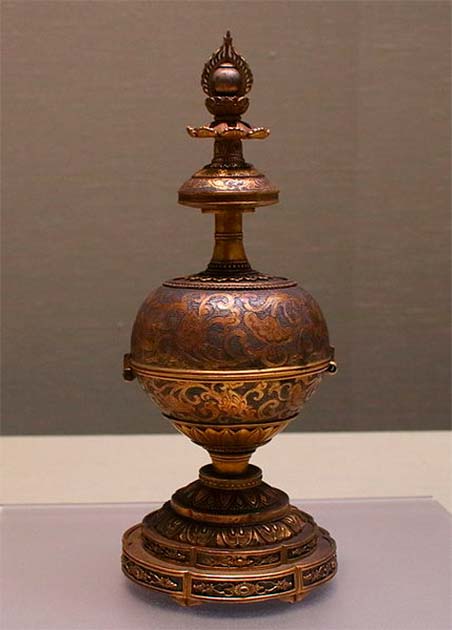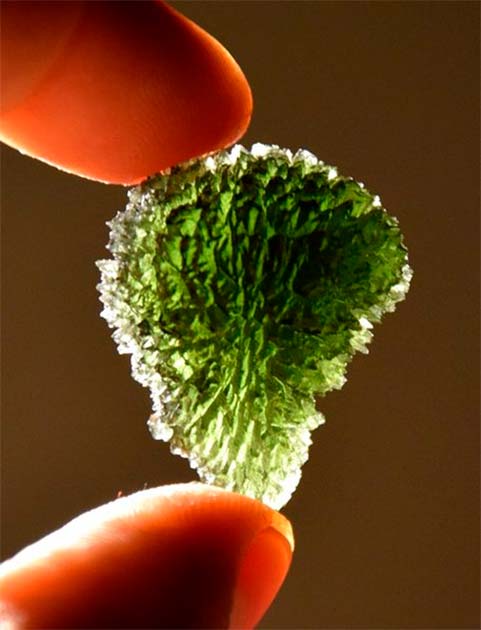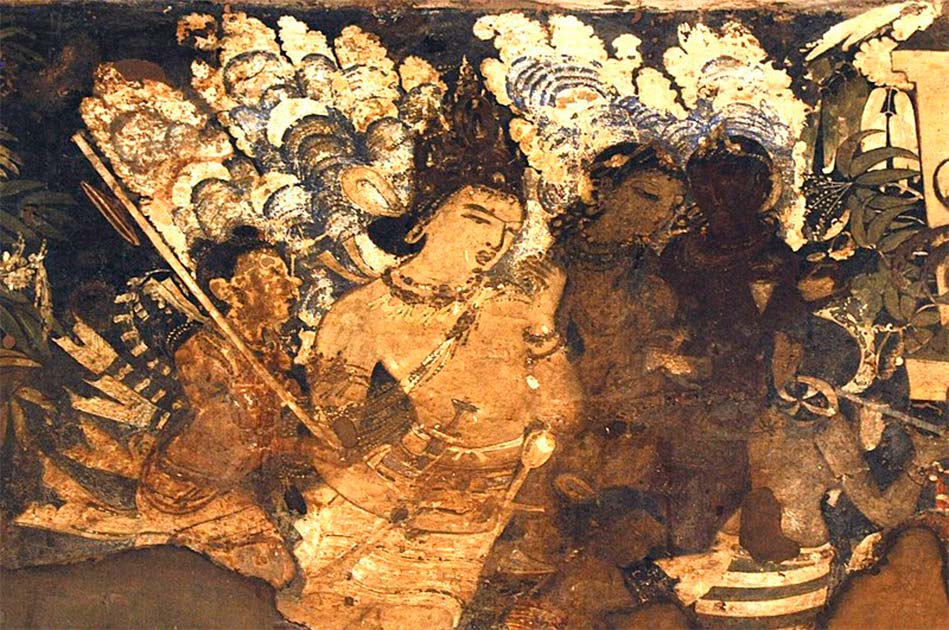The Cintamani, also referred to as the Chintamani, is a wish-fulfilling stone that features across both Hindu and Buddhist religions. According to some, it is the equivalent of the Philosopher’s Stone in the West.
The stone features as one of many Mani Jewel images that can be found in the scripture of Buddhism. In Hinduism, the stone is connected to the gods Ganesha and Vishnu.
Usually, it is depicted as a jewel in Vishnu’s possession known as the Kaustubha. The Kaustubha acts as a sign of divine authority. The stone also features in a story written in the 10th century AD named the Yoga Vasistha. The Hindu Vishnu Purana talks of the Syamanta jewel that grants prosperity to its owner.
In Buddhism, the stone is held by divine beings with great power, wisdom, and compassion known as Avalokiteshvara and Ksitigarbha who were Bodhisattvas (a person or being on the path to awakening). Additionally, it is seen carried on the back of the wind horse, Lung Ta, who can be seen on Tibetan prayer flags.
The Buddhists believe that by reciting a small hymn, the Dharani of Cintamani, they will receive the wisdom of Buddha and enlightenment. In this tradition, the stone is often depicted as a luminous pearl and can be found in the possession of many of the different forms of Buddha.
What are the Mani Jewels?
The Mani Jewels are several gems that are mentioned prominently in Buddhist literature. The written texts and traditions vary between presenting mythical relics and as metaphors for Buddhist Philosophy.

One of the earliest stories presents the jewel as one of the seven treasures owned by a benevolent king, renowned for ruling justly. Additionally, it appears in stories as a crystal that can purify water and be used by traveling monks when in need on their travels.
- Vimanas, The Hindu Machines: Did Ancient India Have Flying Saucers?
- Temple, Spire or Alien Landing Pad? The Mystery of Somapura Mahavihara
It would cleanse the murky water into something clear and drinkable. Researchers claim that this is a metaphor for using faith to overcome doubts and clouded thoughts.
A third depiction of the jewel is found in the net of Indra. This was a net of colossal size and had an infinite number of knots. At the center of these knots lay a Mani Jewel. Each of these jewels reflected each other and was claimed to represent individuals who are interconnected and yet distinguishable.
However, later texts described the Mani Jewels differently, and it was here that the legend of the Cintamani emerged. This was a wish-fulfilling jewel found in the reign of King Lha Thothori Nyantsen of Tibet when it fell from the sky. According to the Mahayana Buddhism lore, the Cintamani is held by those who are making the journey towards Buddahood and have the power to eliminate poverty and suffering.
There are many depictions of deities holding these stones from different religions. It is because of this, that the stones are known as wish-fulfilling stones. In Vedic legends, the initial owner of the jewel was Indra. But the stone dropped to the earth during a huge battle. When it was found on Earth, it granted the owner’s wishes.
Whereas in the Hindu tradition, Vishnu and Gasnesha are connected with the stone as is the Naga king. Despite being a different religion, the stones are still associated with wishes and represent an enlightened mind.
What was it Made From?
Despite there being little evidence to prove the existence of the Cintamani stone, it has been speculated that it was made of moldavite. This is a glass material that was created when a large meteor crashed into the area of the modern-day Czech Republic around 15 million years ago.
In the crystal healing community, Moldavite is considered one of the best stones for enhancing healing and psychic energies. For example, the Emerald Tablet, most famously known for containing alchemical instructions and for being associated with the Philosopher’s Stone, is also thought to be made of moldavite.
- Heaven on Earth: How Do You Find Shangri-La?
- Savitri and Satyavan: The Princess, the Prince and the Secret to Immortality
The legend states that this stone was taken by enlightened people who hid it away in Shambhala, a legendary kingdom that lies North of the Himalayas in Asia. One day, it is said, a king will come from Shambhala and bring forth the Golden Age.

One Russian artist, occultist, and philosopher, Nicholas Roerich, believed that Shambhala was real and set out to find it. He and his wife, Helena, were advocates and students of Theosophy. This is a spiritual belief system that a group of enlightened masters would arise and unite all mankind.
Roerich believed that he had discovered a piece of the Cintamani Stone in the 1920s and because of this set out to find the sacred land of Shambhala. Where he got this piece of the stone is unknown. Some claim that he received it from the League of Nations after peace could not be created after World War One.
In 1929, Nicholas made his first trip to Asia under a ‘Banner of Peace’. Delegates from more than twenty countries attended conferences to discuss a pact put forward by Roerich in which nations were expected to protect and avoid the destruction of cultural heritage during the war and not to neglect them in times of peace.

Despite many trips to Asia, Roerich did not manage to reach Shambhala. However, he did claim that he had discovered a Tibetan location that was deeply associated with the utopian settlement. Roerich lost much of his funding in the 1930s from America as he became known as a megalomaniac.
On top of this letters that Roerich had been writing to Henry A. Wallace about the stone were made public, leading to the embarrassment of them both. Roerich moved to India which helped him avoid this and taxes. He died in 1947.
There are many reasons to be skeptical about the Cintamani stone but there can be no doubt there are many references to it in ancient texts. There are even lists of people who may have held it including King Solomon, Alexander the Great, and the Mughal Emperor Akbar. However, little can be proved at the moment.
Top Image: The Cintamani stone is said to have the power to grant wishes. Source: Stockgiu / Adobe Stock.
By Kurt Readman
